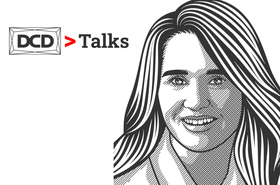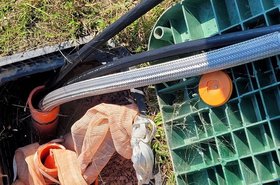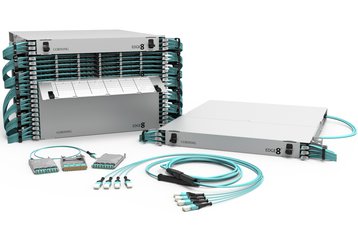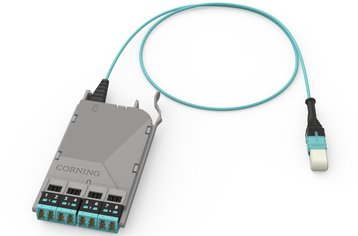Few things in recent history have been as certain as the rapid growth of data – not just since the dawn of the computer revolution, but going as far back as the invention of the printing press. This process shows no sign of slowing down. Data center operators are expected to be on top of clients’ data demands at all times, even as data volumes double every two years or so, as they have done for a number of decades.
Furthermore, the accelerating global rollout of gigabit broadband networks means that these demands are not going to abate any time soon. Indeed, the advent of cloud gaming – with every last pixel being squirted out over the internet – combined with innovations like self-driving vehicles means that data demands are only set to intensify.
The knock-on effect of all this, of course, is that data center operators are forced into costly and time-consuming cycles of installations and upgrades, not just to keep up with demand, but to stay ahead of rivals.
The answer, according to Corning Optical Communications’ market development manager for data center, Carlos Mora, is a combination of innovations that enable faster networking roll-outs, combined with technology that can accommodate bandwidth upgrades without having to be part of any rip-and-replace. “It’s all about scalability, time of deployment, migration, and total cost of ownership,” says Mora.
Furthermore, the volume of work involved in networking a new greenfield campus, let alone upgrading a well-established site, can’t be under-estimated.
“Hyperscale operators are trying to connect volumes and volumes of fiber – it could be 50,000 or 60,000 fibers that they're trying to connect,” Corning’s Jeanne Propst, vice president of global data center sales, told DCD in a recent video interview.
She continues: “Even in a normal situation in a normal market, the challenges you face trying to connect that volume of fibers, are that it takes weeks and weeks to do all the cable prep required, and all the splicing to connect that volume of fibers and that many buildings together.”
As such, adds Mora, Corning has developed a number of innovative products to slash the amount of prep required, as well as its labor intensity, with more new solutions planned for 2022.
Gaining a rapid EDGE
One of those innovations is called EDGE™ Rapid Connect that, Mora says, enables trunk cables between data centers to be installed up to 70 percent faster. This was designed to speed-up data center interconnect (DCI) deployments and connections between data halls with the Corning’s Fast-Track MTP® Connector.
EDGE Rapid Connect reduces the levels of splicing required, and associated testing and troubleshooting, when installing fiber. Connectorized trunk cables are made to order, with Corning on hand (if necessary) to ensure that accurate measurements can be supplied. This is allied with Corning’s Fast-Track MTP Connector and a newly designed water-proofed grip that together enable three 3,456-fiber trunk cables to be pulled through a tight four-inch conduit.
While enabling more fiber to be pulled through existing conduits, the Fast-Track MTP Connector nevertheless mates with standard MTP sockets.
This helps expedite roll-outs for hyperscale operators, but there’s also plenty of innovation left over for enterprise data center implementations as well.
A good example is the CleanAdvantage™ Technology implemented on Corning’s EDGE8® and EDGE™ solutions, introduced in 2020. CleanAdvantage is a new factory cleaning and sealing process to ensure that connectors are not just spotless, but pristine, when the cabling arrives on-site. This should save on time – no more squint-eyed inspections and multiple cleans before connecting – as well as outlay on various consumables.
“We're helping customers to reduce installation times, because they don't have to clean components that are related to the solution. Obviously, this also helps with speed of deployment because, sometimes, if we talk about cleaning, workers will have to clean the same type of connector more than three or four times. And then finally connect,” says Mora.
Inside the data center
Corning’s products and services, says Mora, whether hardware, cabling, networking or services, are all focused on saving time, labor and, by extension, money.
“With the network monitoring and solutions that we have in TAP modules, we can even support ‘port breakout’, which will be very useful for scalability and migration to higher data rates.”
“We have also developed specific types of components, for example, ‘mesh modules’, that can help customers with high density fiber networks, because if you do port breakout at a really high scale, you will have a lot of racks dedicated for that port breakout. With mesh modules, you can reduce all the space that is consumed by a normal port breakout,” he says.
This also relates to Corning’s EDGE8 line of data center solutions. These were designed with technology roadmaps in mind to minimize the work and associated disruption as data centers upgrade transmission speeds from, say, 40G, 100G,400G and even 800G, based on either 2-, 8-, 12- or even 16-fiber connectivity. Corning’s work with transceiver manufacturers indicates that developments from 10 to 800G are leading to the deployment of 2- and 8-fiber connectivity. In addition, 16-fiber connectivity in the data center will be supported with Base-8 solutions, like Corning's EDGE8.
“With Base-8 we help customers to have their data center future-ready with little or no impact on the structured cabling. For some applications, there isn’t even a need to change transceiver, or they may just need to change the jumper connected to the transceiver, while the rest of the infrastructure will remain untouched if enough fiber capacity has been planned,” says Mora.
“If you have a new installation, and you decide to install one of the newer transceivers that work with 16-fibers, with Corning EDGE8 even when all the components are based on eight fibers, you will easily be able to manage those new technologies with 16 fibers that are now on the market,” he adds.
Furthermore, the bigger the data center, the bigger the economies that can be driven from Corning’s EDGE8 and associated innovations.
A hyperscale data center could have 14,000, 50,000 or 60,000 fibers coming into its campus, says Mora, which will then need to be routed across various buildings, floors, halls, routers and servers, and there are a wide range of options that data center builders will need to consider.
“How do you manage 14,000 fibers or more coming into your data center in the best way? What type of cables? Which type of solutions? Which type of hardware will you need to route all of this? What type of trunks or jumpers are the best precisely to deal with all that density and to do that distribution across the data center? And that’s not all.” While Mora can’t say too much, he also revealed to DCD that there are a number of additional time-saving and space-saving solutions that Corning is planning to release in 2022.
“Furthermore,” says Mora, “Corning’s engineering services unit is happy to work on highly customized deployments, as well, working out solutions to particular challenges for clients, helping them to thoroughly plan their installations before work kicks off.”
“People think, ‘Oh yeah, a big company is not going to work on that’. No, we're also focused on customization for customers… we care about our customers no matter if hyperscale, colocation, or enterprise; we care about their needs and we work, obviously, on both standard products, and also customized products for them and with them. So let's work together to develop new solutions.”
To find out more about Corning’s solutions for data centers, click here
More...
-

The challenges that arise with scaling up
And how Corning is helping hyperscalers to tackle them
-

DCD>Talks Connectivity with Jeanne Propst, Corning
We sat down with Jeanne Propst, VP of Global Data Center Sales at Corning Inc. to talk about everything connectivity
-

Sponsored Making data center interconnections faster and easier
Connecting hyperscale data center campus buildings together with high fiber count cabling is costly and time consuming, but there is technology that can slash installation times and costs




